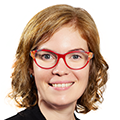Title: Association between peripheral refractive error and 12-month changes in central refraction and axial length in Caucasian children
Authors:Rebecca E. Leighton1, Karen Breslin1, Sara J. McCullough1, Patrick Richardson1, Kathryn J. Saunders1
- Ulster University, Coleraine, Londonderry, United Kingdom
Reference:ARVO 2021 abstract
Summary
有很多evidence for peripheral defocus driving eye growth in animal models. It is a theory of myopia development, progression and control in humans, but building evidence to support the theory has been problematic. Could we measure peripheral refraction to predict children at risk of developing or faster progressing myopia? This study measured central spherical equivalent refraction (SER) and relative peripheral refraction (RPR) in Caucasian children aged 6-7 years and 12-13 years at baseline and again one year later. There was no correlation found between peripheral refraction in the younger group, although none were myopic and only one developed myopia. In the older group, a more hyperopic temporal RPR (at 30 degrees) was found with more central myopia and more myopia progression at 12 months, although RPR only explained around 10% of the variance in SER.
What this means for your clinical practice:the relationship between relative peripheral refraction and on-axis myopia may indicate more a consequence of the myopic shape changes of the eye than a cause of myopia. Perhaps future clinical measurement of RPR in older children may help predict faster myopia progressors, but the contribution of this to overall progression appears to be small.
Abstract
Purpose:关于仙女的影响存在争议pheral visual experience on axial ocular growth in humans. This longitudinal, observational study evaluates the relations between baseline relative peripheral refraction (RPR), change in central refraction and ocular biometry in children aged 6-7 and 12-13 years.
Methods:Cycloplegic autorefraction at horizontal retinal eccentricities of 0° and ±30° were recorded from right eyes (Shin Nippon SRW-5000). The Zeiss IOLMaster 700 measured central axial length (AL) and lens thickness (LT). Measurements were repeated after 12-months. Refractive data were transposed into spherical equivalent refraction (SER). RPR was calculated by subtracting central from peripheral SER. Correlations between baseline RPR and 12-month change in central SER and AL were explored. Multiple regression analyses evaluated the hypothesis that baseline RPR predicts central SER change.
Results:Baseline myopia was associated with more hyperopic RPR and baseline hyperopia and emmetropia with more myopic RPR (all negative correlation r/rho >0.325, p<0.074). More hyperopic temporal RPR at 12-13 years was significantly correlated with greater myopic shift in central SER (r=-0.388, p=0.0008) and greater axial elongation (r=0.376, p=0.011) over 12-months. More hyperopic nasal RPR at 12-13 years was significantly correlated with greater axial elongation (rho=0.333, p=0.025) but not with central SER change (r=-0.158, p=0.301). Neither nasal nor temporal RPR at 6-7 years were correlated with 12-month change in central SER or AL (p>0.675). Multiple regression analyses indicated that baseline central SER, nasal and temporal RPR and AL at 12-13 years explained 21.8% of the variance in 12-month change in central SER (r2=0.218, p=0.04) with temporal RPR the strongest predictor of myopic shift (beta=-0.449, p=0.029). Multiple regression analyses suggest neither RPR, AL or LT at 6-7 years are helpful in predicting subsequent 12-month central SER change.
Conclusions:More hyperopic temporal RPR at 12-13 years is associated with greater short-term myopic progression. This relationship is not seen in younger children. These data suggest that temporal RPR may be a useful metric for eyecare clinicians to consider when developing intervention and review plans for teenage children but are less informative when examining younger children.
Disclosures:Rebecca E. Leighton, None; Karen Breslin, None; Sara J. McCullough, None; Patrick Richardson, None; Kathryn J. Saunders, None

About Kate
Dr Kate Giffordis a clinical optometrist, researcher, peer educator and professional leader from Brisbane, Australia, and a co-founder of Myopia Profile.











